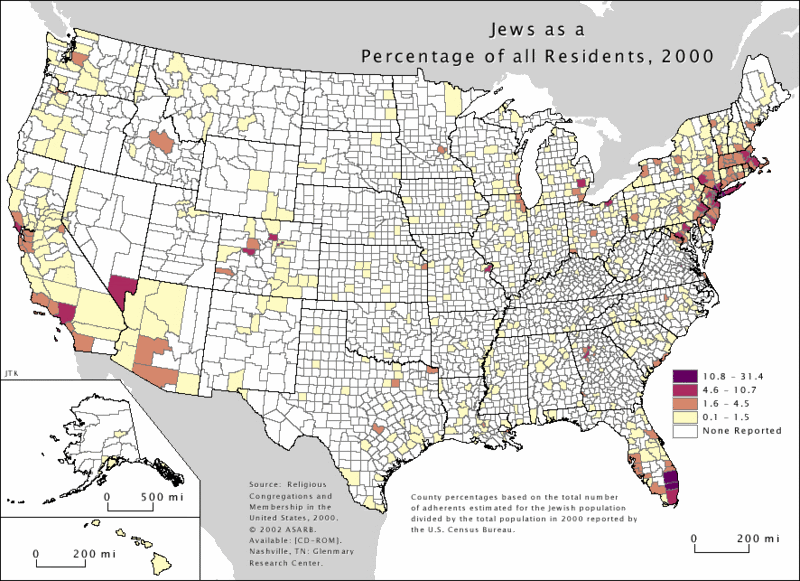
A reassessment of the American Jewish population indicates that it is almost 20 percent larger than previously estimated. Over six million Americans currently identify as Jewish or are children of Jewish parents, according to a study released today by the Steinhardt Social Research Institute (SSRI) at Brandeis University. The Steinhardt Institute also found that the Jewish population includes more non-Orthodox individuals than estimated by existing demographic studies. The entire report can be viewed on the SSRI website.
The SSRI study concludes that the 2000-01 National Jewish Population Study (NJPS), previously considered the authoritative source for data about the Jewish population, substantially underestimated the size and misrepresented the characteristics of U.S. Jewry. NJPS 2000-01 asserted that the American-Jewish population, including those of Jewish background, was 5.2 million and had been in a state of decline since 1990. SSRI concludes that the NJPS finding is in error and that the comparable population figure is between 6 and 6.4 million. In addition, the SSRI study estimates that there are an additional one million individuals who have Jewish parentage and could be considered Jewish, bringing that total potential population to between 7.0-7.4 million.
“Our analyses tell us that the Jewish community is larger and more diverse than most had thought,” said Len Saxe, Professor of Jewish Community Research at Brandeis University and Director of SSRI. “In particular, it is clear that there are many more Jews under 55 years of age, including a significantly larger proportion of children and young adults, than NJPS indicated. Rather than seeing itself in decline, the organized American Jewish community has an exciting opportunity to serve a larger, more diverse population that feels a connection to Jewish life.”
As part of their study of the American Jewish population, Professor Saxe and his team of SSRI researchers reanalyzed NJPS data from 1990 and 2000, as well as conducted a synthesis of data collected from nearly three dozen government and foundation-funded studies on a wide range of topics that included questions on religious, ethnic, and cultural identity. The SSRI researchers concluded that NJPS underestimated the Jewish population, in particular because its telephone methods failed to reach young adults and professionals. The SSRI study found that those surveys with higher response rates identify proportionately more Jewish respondents.
“The Jewish people have made significant contributions to nearly every major facet of American society, so a larger population should be viewed in a very positive light,” said Michael Steinhardt, the renowned hedge fund manager and philanthropist who provided the endowment to establish SSRI. “On the other hand, while there is a larger Jewish population overall, the number of people who are affiliated with Jewish organizations is unchanged. Therefore, the percentage of Jews who are being served by the Jewish community is actually less than previously thought. This leads us to an important question, has the present institutional structure in the Jewish world been responsible for the severe decline in affiliation? On a deeper level, we might wonder if that with so many more people openly Jewish but unconnected, should we not explore ways to reinvent the Jewish community in order to reach them?”
birthright Israel (BRI), a philanthropic project that Mr. Steinhardt—chairman of Jewish Life Network/Steinhardt Foundation, which was instrumental in the development of SSRI—co-founded and continues to support, is a striking case in point. BRI offers educational trips to Israel for American Jews age 18-26, and evaluation studies indicate that it has been highly successful in infusing participants with stronger Jewish identity. Although BRI has engaged more than 15,000 young adults from the U.S. per year, according to SSRI’s analysis, there are nearly 800,000 young adults eligible for the program – more than twice as many than previously suggested by NJPS.
The larger population estimated by SSRI has similar implications for other educational and cultural programs. For example, the Jewish Early Childhood Education Initiative (JECEI), another project spearheaded by Mr. Steinhardt along with seven other foundations and federations, had been operating under the assumption that 30 percent of Jewish preschoolers attended Jewish early childhood programs. According to SSRI, the real figure is closer to 15-20 percent, which means that JECEI’s mandate to enhance the quality of Jewish preschools as a means to appeal to and engage unaffiliated families in Jewish life and learning is that much more pressing. SSRI’s findings are sure to lead to other changes as well, necessitating larger fund-raising goals for Jewish organizations, influencing policy decisions, and even changing the way the American public—and politicians—view the Jewish community.
“Of course I’m pleased to know that the American Jewish community is larger than we thought,” added Mr. Steinhardt, “but we also have to acknowledge the downside implicit in the findings, which is that active involvement in Jewish life is lower than we thought. The good news, however, is that we can use this new information to reinvigorate our efforts towards causing a renaissance in Jewish life. Speaking for myself, I’ve heard the clarion call, and I’m excited to get to it.”

RELATED ARTICLES
- Birth rates over the past year dropped 23% in Taiwan
- Italy Scores the Lowest number of Births in 2020 since its Entire History
- COVID Pandemic Will Lead To HALF A MILLION Fewer U.S. Births In 2021
- Norwegian Women Urged to Spark Baby Boom as Fertility Rates Plummet
- Tory MP Warns: Plummeting Birthrates Are Biggest Threat to Western Society











